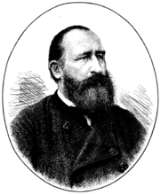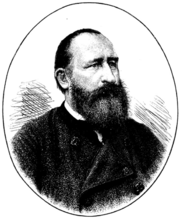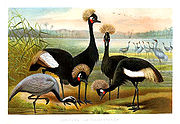
Alfred Brehm
Encyclopedia

called Renthendorf
Renthendorf
Renthendorf is a municipality in the district Saale-Holzland, in Thuringia, Germany....
; died November 11, 1884 in Renthendorf) was a
German
Germany
Germany , officially the Federal Republic of Germany , is a federal parliamentary republic in Europe. The country consists of 16 states while the capital and largest city is Berlin. Germany covers an area of 357,021 km2 and has a largely temperate seasonal climate...
zoologist, natural history illustrator and writer
Writer
A writer is a person who produces literature, such as novels, short stories, plays, screenplays, poetry, or other literary art. Skilled writers are able to use language to portray ideas and images....
, the son of
Christian Ludwig Brehm
Christian Ludwig Brehm
Christian Ludwig Brehm was a German pastor and ornithologist. He was the father of Alfred Brehm.Brehm was born near Gotha, and studied at the University of Jena. In 1813 he became the minister at Renthendorf, a village sixty miles south of Leipzig, where he remained until his death...
.
Through the book title Brehms Tierleben
Brehms Tierleben
Brehms Tierleben is a reference book, first published in the 1860s,which made its author, Alfred Edmund Brehm ,known around the world.- Publishing history :...
, his name became a synonym
for popular zoological literature.
Alfred Brehm was brought up in the small Thuringia
Thuringia
The Free State of Thuringia is a state of Germany, located in the central part of the country.It has an area of and 2.29 million inhabitants, making it the sixth smallest by area and the fifth smallest by population of Germany's sixteen states....
n village
Unterrenthendorf as the son of the minister Christian Ludwig Brehm
and his second wife Bertha. Christian Ludwig Brehm made a name for
himself as an ornithologist by publications and an extensive collection
of stuffed birds. The collection, held in the parsonage and
consisting of over 9,000 dead birds, offered a glimpse into the world of
European birds. His father's research gave Brehm an interest in zoology
Zoology
Zoology |zoölogy]]), is the branch of biology that relates to the animal kingdom, including the structure, embryology, evolution, classification, habits, and distribution of all animals, both living and extinct...
,
but at first he wanted to become an architect
Architect
An architect is a person trained in the planning, design and oversight of the construction of buildings. To practice architecture means to offer or render services in connection with the design and construction of a building, or group of buildings and the space within the site surrounding the...
.
In the spring of 1844 he began to study with a builder in Altenburg
Altenburg
Altenburg is a town in the German federal state of Thuringia, 45 km south of Leipzig. It is the capital of the Altenburger Land district.-Geography:...
.
He continued his studies there until September 1846, when he left for
Dresden
Dresden
Dresden is the capital city of the Free State of Saxony in Germany. It is situated in a valley on the River Elbe, near the Czech border. The Dresden conurbation is part of the Saxon Triangle metropolitan area....
in order to study architecture; however, he stopped after two
semesters because Johann Wilhelm von Müller
Johann Wilhelm von Müller
Baron Johann Wilhelm von Müller was a German ornithologist and explorer.Müller was born in Kochersteinsfeld, Neckarsulm, the grandson of the banker Johannes Müller. In 1845 he travelled to Morocco and Algiers, and in 1847 embarked on a longer African journey, accompanied by Alfred Brehm as his...
,
a well-known ornithologist, was looking for a companion for an
Africa
Africa
Africa is the world's second largest and second most populous continent, after Asia. At about 30.2 million km² including adjacent islands, it covers 6% of the Earth's total surface area and 20.4% of the total land area...
n expedition. Brehm joined the
expedition on May 31, 1847 as a secretary and assistant to von Müller.
The expedition took him to Egypt
Egypt
Egypt , officially the Arab Republic of Egypt, Arabic: , is a country mainly in North Africa, with the Sinai Peninsula forming a land bridge in Southwest Asia. Egypt is thus a transcontinental country, and a major power in Africa, the Mediterranean Basin, the Middle East and the Muslim world...
, the Sudan
Sudan
Sudan , officially the Republic of the Sudan , is a country in North Africa, sometimes considered part of the Middle East politically. It is bordered by Egypt to the north, the Red Sea to the northeast, Eritrea and Ethiopia to the east, South Sudan to the south, the Central African Republic to the...
, and the Sinai peninsula
Sinai Peninsula
The Sinai Peninsula or Sinai is a triangular peninsula in Egypt about in area. It is situated between the Mediterranean Sea to the north, and the Red Sea to the south, and is the only part of Egyptian territory located in Asia as opposed to Africa, effectively serving as a land bridge between two...
;
the discoveries made were so important that, at the age of only 20,
he was made a member of the German Academy of Natural Scientists Leopoldina
German Academy of Natural Scientists Leopoldina
The Leopoldina is the national academy of Germany.Historically it was known under the German name Deutsche Akademie der Naturforscher Leopoldina until 2007, when it was declared the national academy of Germany.The Leopoldina is currently located in Halle...
.
After his return, in 1853 he started to study natural sciences at the
University of Jena. Like his brother Reinhold, he became active with the
student corps
German Student Corps
Corps are the oldest still-existing kind of Studentenverbindung, Germany's traditional university corporations; their roots date back to the 15th century. The oldest corps still existing today was founded in 1789...
Saxonia Jena
Jena
Jena is a university city in central Germany on the river Saale. It has a population of approx. 103,000 and is the second largest city in the federal state of Thuringia, after Erfurt.-History:Jena was first mentioned in an 1182 document...
;
because of his expedition to North Africa
North Africa
North Africa or Northern Africa is the northernmost region of the African continent, linked by the Sahara to Sub-Saharan Africa. Geopolitically, the United Nations definition of Northern Africa includes eight countries or territories; Algeria, Egypt, Libya, Morocco, South Sudan, Sudan, Tunisia, and...
, he received the nickname Pharaoh
from his corps brothers. He graduated after four semesters in 1855
and in 1856 went on a two-year journey to Spain
Spain
Spain , officially the Kingdom of Spain languages]] under the European Charter for Regional or Minority Languages. In each of these, Spain's official name is as follows:;;;;;;), is a country and member state of the European Union located in southwestern Europe on the Iberian Peninsula...
with his brother
Reinhold. Afterwards he settled down in Leipzig
Leipzig
Leipzig Leipzig has always been a trade city, situated during the time of the Holy Roman Empire at the intersection of the Via Regia and Via Imperii, two important trade routes. At one time, Leipzig was one of the major European centres of learning and culture in fields such as music and publishing...
as a freelance writer and
wrote many scientific popularizations for Die Gartenlaube
Die Gartenlaube
Die Gartenlaube Illustrirtes Familienblatt , was a forerunner of modern magazines, and the first major success of the German weekly. The name means "The Garden Arbor Family Journal" but the magazine is known worldwide as "Die Gartenlaube"...
and other
magazines. Apart from this, he undertook an expedition to Norway
Norway
Norway , officially the Kingdom of Norway, is a Nordic unitary constitutional monarchy whose territory comprises the western portion of the Scandinavian Peninsula, Jan Mayen, and the Arctic archipelago of Svalbard and Bouvet Island. Norway has a total area of and a population of about 4.9 million...
and Lapland
in 1860.
In May 1861 Brehm married his cousin Mathilde Reiz,
with whom he had five children. Since he wanted to travel, in 1862 he accepted the invitation of
Duke Ernst II of Saxe-Coburg-Gotha
Ernst II, Duke of Saxe-Coburg and Gotha
Ernest II, Duke of Saxe-Coburg and Gotha was the second sovereign duke of the German duchy of Saxe-Coburg and Gotha, reigning from 1844 to his death...
to accompany him on a trip to Abyssinia
Ethiopia
Ethiopia , officially known as the Federal Democratic Republic of Ethiopia, is a country located in the Horn of Africa. It is the second-most populous nation in Africa, with over 82 million inhabitants, and the tenth-largest by area, occupying 1,100,000 km2...
. Afterwards, Brehm travelled
to Africa as well as to Scandinavia
Scandinavia
Scandinavia is a cultural, historical and ethno-linguistic region in northern Europe that includes the three kingdoms of Denmark, Norway and Sweden, characterized by their common ethno-cultural heritage and language. Modern Norway and Sweden proper are situated on the Scandinavian Peninsula,...
and Siberia
Siberia
Siberia is an extensive region constituting almost all of Northern Asia. Comprising the central and eastern portion of the Russian Federation, it was part of the Soviet Union from its beginning, as its predecessor states, the Tsardom of Russia and the Russian Empire, conquered it during the 16th...
. His essays and
expedition
reports from the animal world were well-received by the educated bourgeoisie;
because of this, he was commissioned by
the editor of the Bibliographisches Institut
Bibliographisches Institut
The German publishing company "Bibliographisches Institut" was founded 1826 in Gotha by Joseph Meyer, moved 1828 to Hildburghausen and 1874 to Leipzig. Its production over the years includes such well-known titles as "Meyers Lexikon" , "Brehms Tierleben" The German publishing company...
, Herrmann Julius Meyer
Herrmann Julius Meyer
Herrmann Julius Meyer was a German publisher born in Gotha. He was the son of publisher Joseph Meyer ....
,
to write a large multivolume work on the animal world.
This book became known worldwide as Brehms Tierleben (or, in English,
Brehm's Life of Animals). Although Brehm's ethology is no longer seen
as correct, the title of his work is still a catchphrase.
Brehm's life was full with writing, scientific expeditions and lecture tours. Despite this, in 1862, he accepted the post of first director of the Zoological Garden of Hamburg
Zoological Garden of Hamburg
The Zoological Garden of Hamburg was a zoo in Hamburg, Germany that operated from 1863 until 1930. Its aquarium, which opened in 1864, was among the first in the world.- Founding :...
and kept this position until 1867. Afterwards he went to Berlin
Berlin
Berlin is the capital city of Germany and is one of the 16 states of Germany. With a population of 3.45 million people, Berlin is Germany's largest city. It is the second most populous city proper and the seventh most populous urban area in the European Union...
, where he opened an aquarium
Aquarium
An aquarium is a vivarium consisting of at least one transparent side in which water-dwelling plants or animals are kept. Fishkeepers use aquaria to keep fish, invertebrates, amphibians, marine mammals, turtles, and aquatic plants...
. He remained with the aquarium until 1874. In the winter of 1883 to 1884 Brehm planned a lecture tour to the USA. Shortly before his departure, his four children contracted diphtheria
Diphtheria
Diphtheria is an upper respiratory tract illness caused by Corynebacterium diphtheriae, a facultative anaerobic, Gram-positive bacterium. It is characterized by sore throat, low fever, and an adherent membrane on the tonsils, pharynx, and/or nasal cavity...
. Since he could not afford to break his contract, Brehm, a widower since 1878, went ahead with his tour. At the end of January he received word of his youngest son's death. After the hardship of this news Brehm relapsed into malaria
Malaria
Malaria is a mosquito-borne infectious disease of humans and other animals caused by eukaryotic protists of the genus Plasmodium. The disease results from the multiplication of Plasmodium parasites within red blood cells, causing symptoms that typically include fever and headache, in severe cases...
, which he had caught in Africa in his expedition days. On May 11, 1884, he came back to Berlin. In order to find peace,
he returned in July to his home town of Renthendorf, where he died on November 11, 1884. Today, the Brehm Memorial Museum is located there.

Selected publications
- Brehms Tierleben (English title: Brehm's Life of Animals.) See the article on Brehms Tierleben for its editions, titles and availability of online text.
- Reiseskizzen aus Nord-Ost-Afrika (1855, 3 vols., pub. Friedrich Mauke, Jena.)
- Das Leben der Vögel (pub. C. Flemming, Glogau, 1861; second edition 1867.)
- Ergebnisse einer Reise nach Habesch (1863, pub. O. Meissner, HamburgHamburg-History:The first historic name for the city was, according to Claudius Ptolemy's reports, Treva.But the city takes its modern name, Hamburg, from the first permanent building on the site, a castle whose construction was ordered by the Emperor Charlemagne in AD 808...
.) - Die Thiere des Waldes, with Emil Adolf Rossmässler (2 vols., 1864–1867, pub. C. F. Winter, Leipzig and HeidelbergHeidelberg-Early history:Between 600,000 and 200,000 years ago, "Heidelberg Man" died at nearby Mauer. His jaw bone was discovered in 1907; with scientific dating, his remains were determined to be the earliest evidence of human life in Europe. In the 5th century BC, a Celtic fortress of refuge and place of...
.) - Gefangene Vögel, with Otto FinschOtto FinschFriedrich Hermann Otto Finsch was a German ethnographer, naturalist and colonial explorer.-Biography:...
(2 vols., 1872–1876, pub. C.F. Winter'sche Verlagshandlung, Leipzig.)

External links
- Entomologie Vieux livres A. E. Brehm (French) Information on and table of contents from the work Merveilles de la nature: les insectes, A. E. Brehm, tr. J. Künckel d'Herculais. (In Dutch)
- Project Gutenberg-DE page on Brehm (German) Includes text from Brehms Thierleben and Tiergeschichten.
- Page on Brehm (German)

